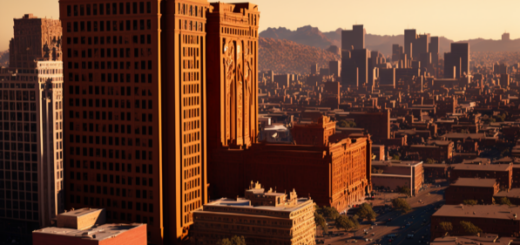The 5 most famous museums in the world that are worth visiting

Museums are institutions that preserve and display works of art, historical artifacts, and scientific specimens for public viewing. They can be found all over the world, in cities, towns, and even rural areas.
Museums are typically associated with cultural heritage, providing evidence of past events, people, and cultures. They can also provide educational opportunities, allowing people to explore the world around them in more detail and to develop a deeper appreciation for the knowledge and experiences of others.
The Hermitage, St. Petersburg
The Hermitage is a world-renowned art museum located in St. Petersburg, Russia. Founded by Empress Catherine the Great in 1764, it is one of the oldest and largest art museums in the world. The collection includes over three million works of art, including paintings, sculptures, artifacts, and more. The Hermitage is divided into five main buildings: the Winter Palace, the Small Hermitage, the Old Hermitage, the New Hermitage, and the Hermitage Theatre.
The Winter Palace is the main building of the Hermitage. It was originally built as the primary residence for the Russian royalty, and now contains many of the museum’s most famous works of art. It includes a variety of galleries, including the State Rooms, the Great Hall, the Picture Gallery, and the Private Quarters. The State Rooms are particularly famous and contain many famous paintings, such as Rembrandt’s The Return of the Prodigal Son and Leonardo da Vinci’s Benois Madonna.
The Small Hermitage is home to the Hermitage’s collection of Impressionist and Post-Impressionist paintings. It also contains the works of many European and Russian artists, such as Monet, Renoir, Pissarro, and Kandinsky.
The Old Hermitage is home to the Hermitage’s collection of ancient Greek and Roman artifacts. It also contains the works of many European and Russian artists, such as Michelangelo, Rubens, and Goya.
The New Hermitage is home to the Hermitage’s collection of modern and contemporary art. It includes works by Picasso, Matisse, and Chagall.
The Hermitage Theatre is home to the Hermitage’s collection of theatrical art and artifacts. It was originally built as a theatre for the Russian Imperial family and now contains many works of art and artifacts related to the theatre, such as costumes, set designs, and more.
The Louvre, Paris
The Louvre is the world’s largest art museum and a historic monument in Paris, France. It is situated on the Right Bank of the River Seine in the 1st arrondissement. It houses over 380,000 objects, spanning from prehistory to the 21th century. The Louvre is one of the most visited museums in the world.
The Louvre contains some of the world’s most famous works of art, such as the Mona Lisa, the Winged Victory of Samothrace, Venus de Milo, Liberty Leading the People, and the Code of Hammurabi. Other highlights include the Louvre Pyramid, the Cour Carrée and the Grande Galerie.
The Louvre also houses an extensive collection of sculptures, artifacts, furniture, coins, and other objects from around the world. The museum also has a library with over 450,000 books and manuscripts. It also has a department dedicated to the conservation and restoration of works of art.
The Louvre has a number of educational programs and activities, which include guided tours, lectures, and workshops. It also offers a number of special exhibitions throughout the year.
The British Museum, London
The British Museum, located in London, is one of the world’s most visited and celebrated museums. It is the UK’s national museum and one of the oldest and largest museums in the world. It was founded in 1753 and opened to visitors in 1759, making it the first national public museum in the world. The museum holds over 8 million objects from all continents, illustrating and documenting the story of human culture from its beginning to the present.
The British Museum’s collection consists of artifacts from throughout history, from ancient Egyptian mummies, to Greek and Roman sculptures, to Anglo-Saxon treasures, to historical pieces from the Middle Ages and Renaissance.
The museum also houses an impressive collection of antiquities from ancient civilizations such as Mesopotamia, the Indus Valley, and the Far East. These include the famous Elgin Marbles, which were originally part of the Parthenon, and the Rosetta Stone, which helped scholars decipher Egyptian hieroglyphics.
The British Museum also houses a comprehensive library, which is open to public use. The library contains over 4.5 million books, journals, and manuscripts.
The museum’s galleries are open daily and offer a range of educational and interactive activities, including hands-on activities, gallery talks, and guided tours. Visitors can also take part in a range of special events, such as lectures and workshops.
The British Museum is free to visit, but there are charges for some exhibitions, events, and activities.
The Metropolitan Museum of Art, New York City
The Metropolitan Museum of Art, located in New York City, is one of the world’s largest and most important art museums. It houses a vast collection of over 2 million works of art, spanning 5,000 years of world culture from ancient Egyptian, Greek, and Roman art to the art of the Renaissance and European masters, 19th- and 20th-century art, and modern and contemporary art. The museum also has extensive holdings of Islamic, African, Asian, and Oceanic art, as well as a large photography collection.
The museum’s main building is located on the eastern edge of Central Park on Fifth Avenue in Manhattan. This iconic building was designed by Calvert Vaux and Jacob Wrey Mould in the Neo-Gothic style and opened in 1880. In addition to its main building, the museum has two additional locations, the The Cloisters in Fort Tryon Park in Upper Manhattan and the Met Breuer on Madison Avenue.
The Metropolitan Museum of Art features an array of exhibitions, educational programs, and public events that are designed to make art accessible to everyone. These include lectures, concerts, workshops, guided tours, and family activities. Visitors can also explore the galleries on their own, using the museum’s audio guide and mobile app.
The museum also has an extensive library and curatorial staff, who help to develop new exhibitions, research and educate the public, and conserve artwork. The Met also has an active publications program, which produces catalogues, books, and periodicals related to the museum’s collections and exhibitions.
The Prado, Madrid
The Prado Museum in Madrid, Spain is one of the most important and well-known art museums in the world. It features a vast collection of European art from the 12th to the 19th centuries, comprised of more than 7,000 paintings, 1,000 sculptures, 4,800 prints, and 8,200 drawings.
Some of the most notable works in the museum’s collection include Las Meninas by Diego Velázquez, Garden of Earthly Delights by Hieronymus Bosch, and The Third of May 1808 by Francisco de Goya. The museum also has exemplary collections of Flemish, Dutch, French, and Italian art, as well as one of the best collections of works by El Greco in the world.
The Prado Museum is housed in a large neoclassical building that was constructed in 1819. It is located in the heart of Madrid, near the Atocha railway station and a handful of other major museums and attractions. Inside the building, visitors will find more than 100 galleries, display rooms, and exhibitions, as well as a library, auditorium, and restaurant.
The Prado Museum is open Tuesday through Sunday, and the hours are 10 am to 8 pm. Admission is free on Mondays, but only after 3 pm, and tickets are available for purchase online and at the museum.
FAQ
Some of the most popular museums in the world include the Louvre in Paris, the British Museum in London, the Prado in Madrid, the Smithsonian Institution in Washington, DC, the Forbidden City in Beijing, and the Uffizi Gallery in Florence.
Visiting museums can provide educational opportunities and a chance to discover and appreciate culture and history.
There are a few ways to find museums near you. You can search for local museums on sites like TripAdvisor, Google, or the official website of the country or city you are visiting.



